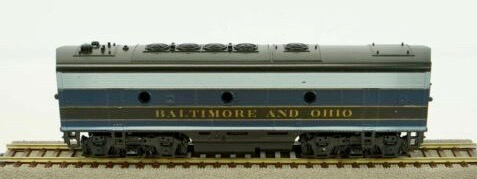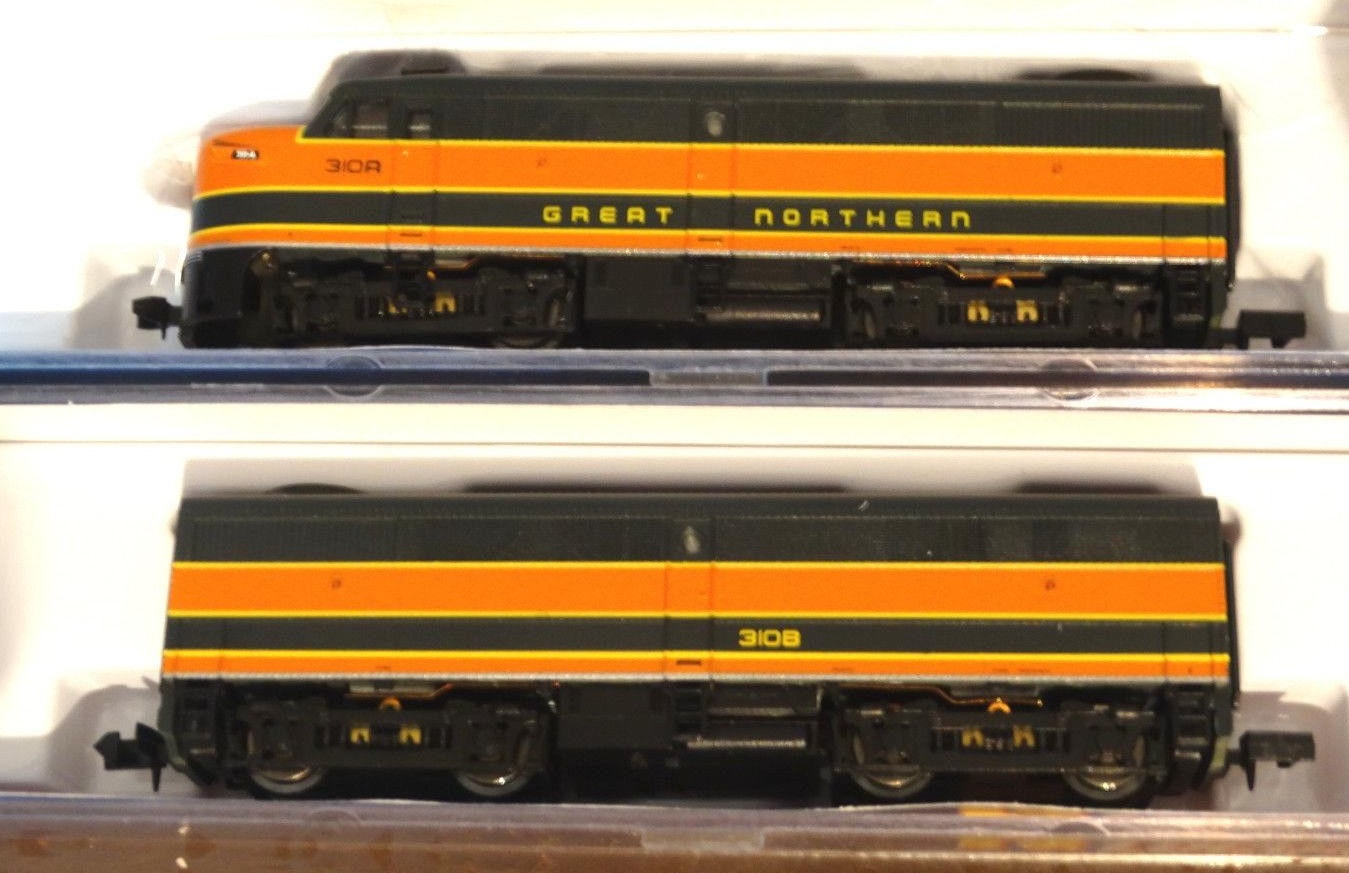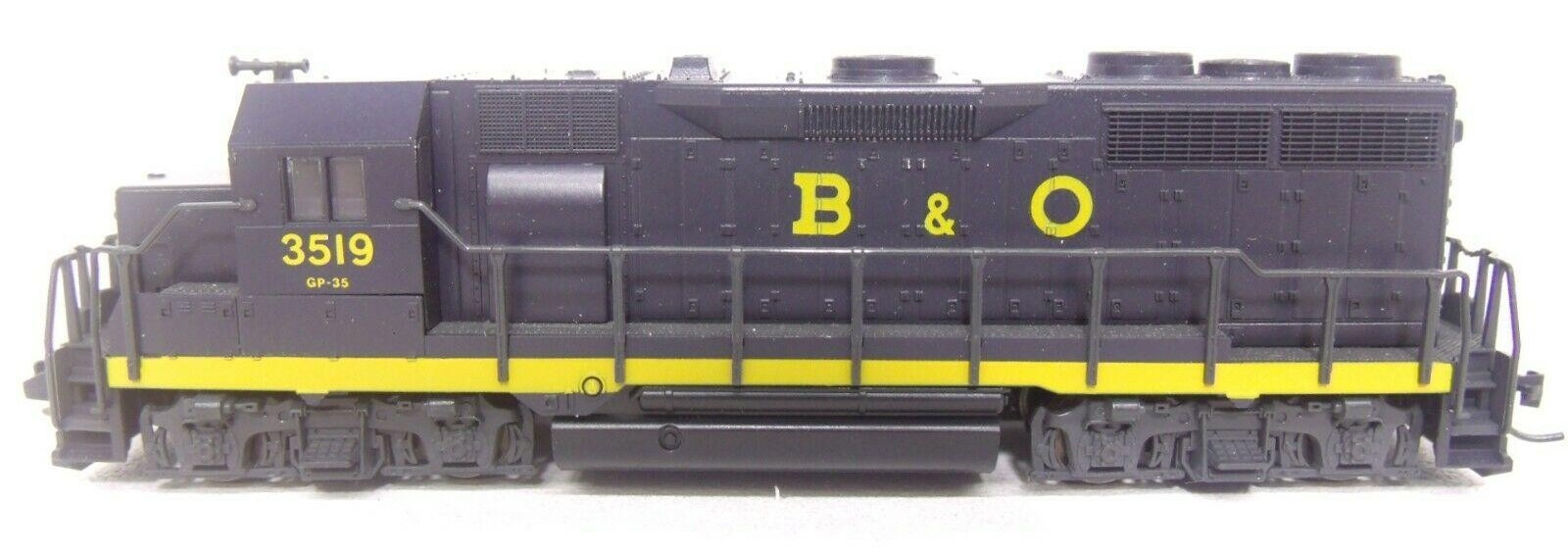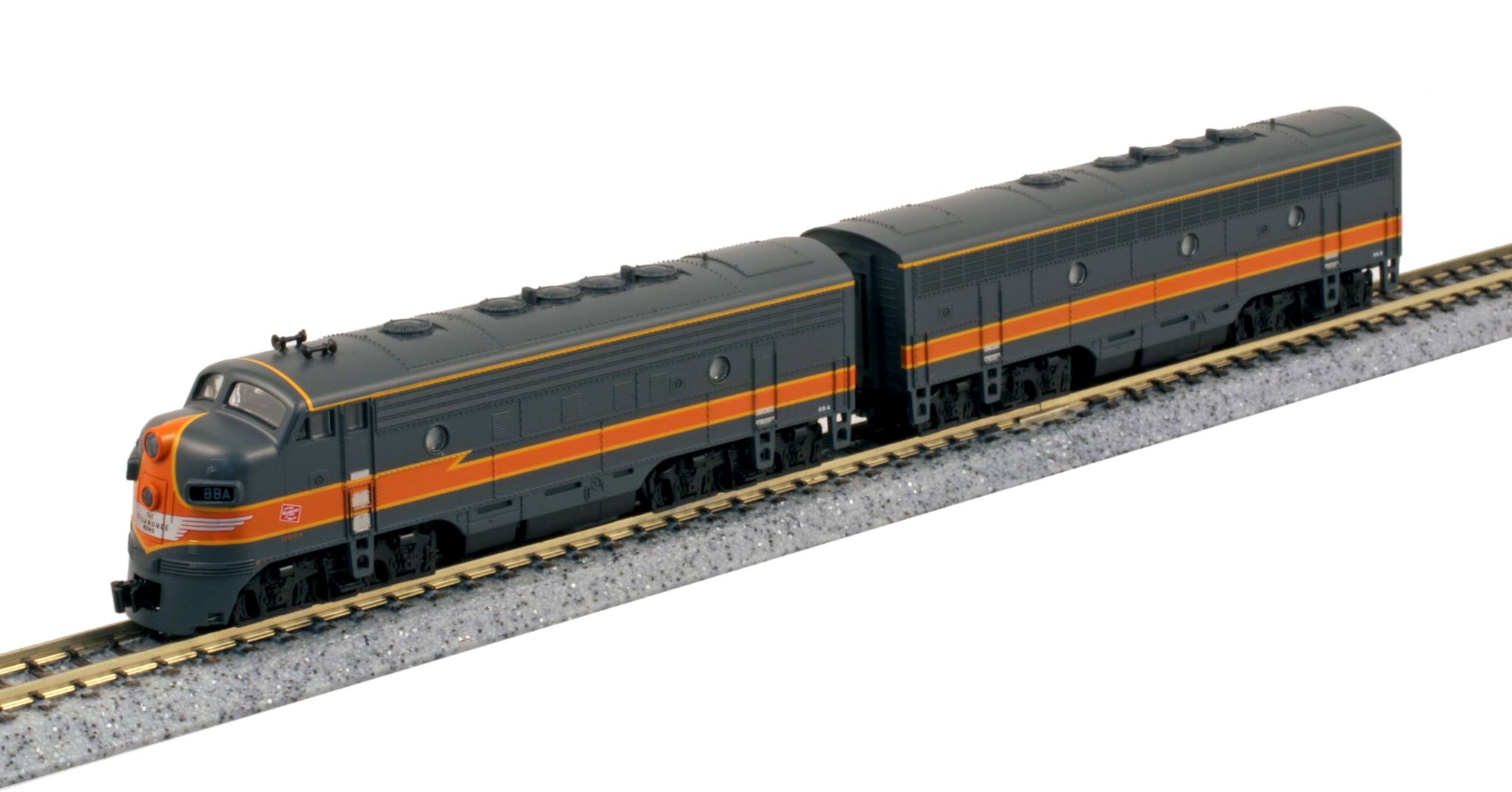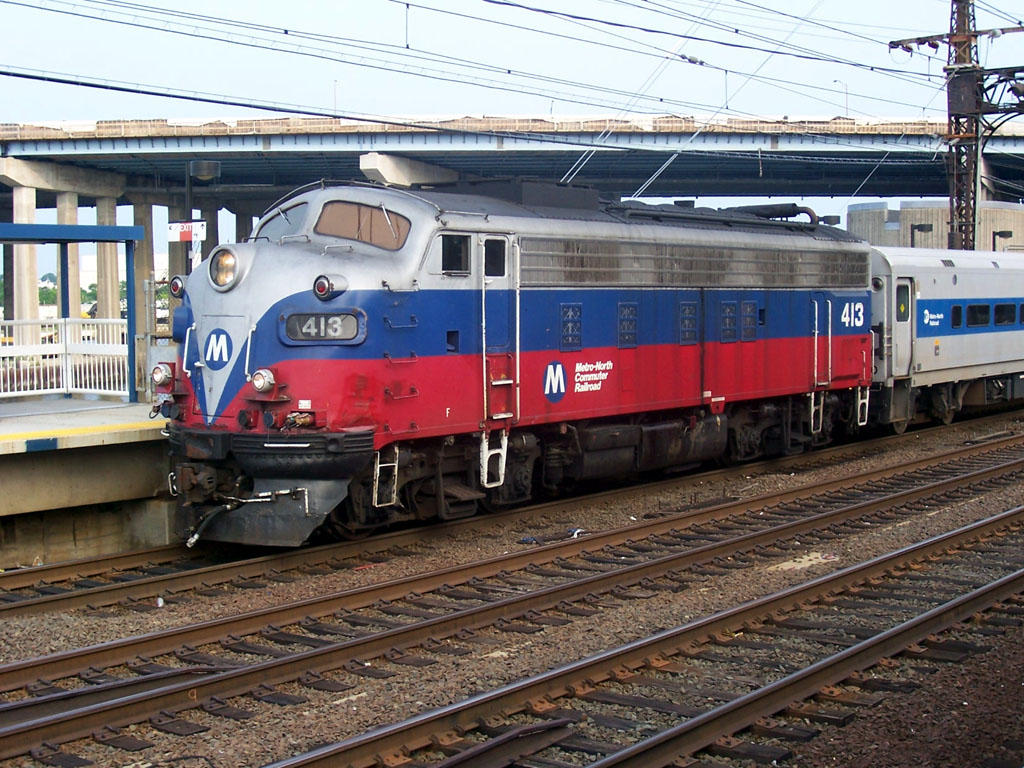Model Information: The Kato F2, F3 and F7 all share the same mechanism. They differ only in shell details. Kato introduced the F3 model in 1988 and then followed up with the F7 in 1992. In 2003 a major overhaul introduced a DCC-Ready mechanism to the F3 and then in 2006 a similar update was performed for the F7. In 2014, a DCC-Ready version of the F2 was added to the roster.
Like the Atlas Geeps, these models have been a staple of Kato engine production for decades. They have undergone numerous revisions, each offering significant upgrades in features in performance. They have always been good runners (I have an older B&O AB pair I love to operate) but they get better with each update. Even the earliest models featured a modern split-frame design and are very heavy for their size. This probably aids in their excellent smooth operation. Later releases permitted easy DCC-installation (though they remain 'Friendly' rather than 'Ready'), Kato knuckle couplers and low-profile wheels. All versions run quietly.
Like the Atlas Geeps, these models have been a staple of Kato engine production for decades. They have undergone numerous revisions, each offering significant upgrades in features in performance. They have always been good runners (I have an older B&O AB pair I love to operate) but they get better with each update. Even the earliest models featured a modern split-frame design and are very heavy for their size. This probably aids in their excellent smooth operation. Later releases permitted easy DCC-installation (though they remain 'Friendly' rather than 'Ready'), Kato knuckle couplers and low-profile wheels. All versions run quietly.
DCC Information: The current model of F3A may be upgraded to DCC with a Digitrax DN163K0B decoder
Prototype History: The EMD F3 was a 1,500-horsepower (1,100 kW) B-B freight- and passenger-hauling diesel locomotive produced between July 1945 and February 1949 by General Motors’ Electro-Motive Division. Final assembly was at GM-EMD's La Grange, Illinois plant. A total of 1,111 cab-equipped lead A units and 696 cabless booster B units were built.
The F3 was the third model in GM-EMD's highly successful F-unit series of cab unit diesel locomotives, and it was the second most produced of the series. The F3 essentially differed from the EMD F2 in that it used the “new” D12 generator to produce more power, and from the later EMD F7 in electrical equipment. Some late-model F3's had the same D27 traction motors, along with the heavier-duty electrical cables, used in the F7, and were referred to as model F5 by EMD's Engineering Department.
From Wikipedia
Read more on American-Rails.com
The F3 was the third model in GM-EMD's highly successful F-unit series of cab unit diesel locomotives, and it was the second most produced of the series. The F3 essentially differed from the EMD F2 in that it used the “new” D12 generator to produce more power, and from the later EMD F7 in electrical equipment. Some late-model F3's had the same D27 traction motors, along with the heavier-duty electrical cables, used in the F7, and were referred to as model F5 by EMD's Engineering Department.
From Wikipedia
Read more on American-Rails.com
Road Name History: The Baltimore and Ohio Railroad (reporting marks B&O, BO) is one of the oldest railroads in the United States and the first common carrier railroad. It came into being mostly because the city of Baltimore wanted to compete with the newly constructed Erie Canal (which served New York City) and another canal being proposed by Pennsylvania, which would have connected Philadelphia and Pittsburgh. At first this railroad was located entirely in the state of Maryland with an original line from the port of Baltimore west to Sandy Hook. At this point to continue westward, it had to cross into Virginia (now West Virginia) over the Potomac River, adjacent to the confluence of the Potomac and Shenandoah rivers. From there it passed through Virginia from Harpers Ferry to a point just west of the junction of Patterson Creek and the North Branch Potomac River where it crossed back into Maryland to reach Cumberland. From there it was extended to the Ohio River at Wheeling and a few years later also to Parkersburg, West Virginia.
It is now part of the CSX Transportation (CSX) network, and includes the oldest operational railroad bridge in the USA. The B&O also included the Leiper Railroad, the first permanent horse-drawn railroad in the U.S. In later years, B&O advertising carried the motto: "Linking 13 Great States with the Nation." Part of the B&O Railroad's immortality has come from being one of the four featured railroads on the U.S. version of the board game Monopoly, but it is the only railroad on the board which did not serve Atlantic City, New Jersey, directly.
When CSX established the B&O Railroad Museum as a separate entity from the corporation, some of the former B&O Mount Clare Shops in Baltimore, including the Mt. Clare roundhouse, were donated to the museum while the rest of the property was sold. The B&O Warehouse at the Camden Yards rail junction in Baltimore now dominates the view over the right-field wall at the Baltimore Orioles' current home, Oriole Park at Camden Yards.
At the end of 1970 B&O operated 5552 miles of road and 10449 miles of track, not including the Staten Island Rapid Transit (SIRT) or the Reading and its subsidiaries.
Read more on Wikipedia.
It is now part of the CSX Transportation (CSX) network, and includes the oldest operational railroad bridge in the USA. The B&O also included the Leiper Railroad, the first permanent horse-drawn railroad in the U.S. In later years, B&O advertising carried the motto: "Linking 13 Great States with the Nation." Part of the B&O Railroad's immortality has come from being one of the four featured railroads on the U.S. version of the board game Monopoly, but it is the only railroad on the board which did not serve Atlantic City, New Jersey, directly.
When CSX established the B&O Railroad Museum as a separate entity from the corporation, some of the former B&O Mount Clare Shops in Baltimore, including the Mt. Clare roundhouse, were donated to the museum while the rest of the property was sold. The B&O Warehouse at the Camden Yards rail junction in Baltimore now dominates the view over the right-field wall at the Baltimore Orioles' current home, Oriole Park at Camden Yards.
At the end of 1970 B&O operated 5552 miles of road and 10449 miles of track, not including the Staten Island Rapid Transit (SIRT) or the Reading and its subsidiaries.
Read more on Wikipedia.
Brand/Importer Information: KATO U.S.A. was established in 1986, with the first U.S. locomotive model (the GP38-2, in N-Scale) released in 1987. Since that time, KATO has come to be known as one of the leading manufacturers of precision railroad products for the modeling community. KATO's parent company, Sekisui Kinzoku Co., Ltd., is headquartered in Tokyo, Japan.
In addition to producing ready-to-run HO and N scale models that are universally hailed for their high level of detail, craftsmanship and operation, KATO also manufactures UNITRACK. UNITRACK is the finest rail & roadbed modular track system available to modelers today. With the track and roadbed integrated into a single piece, UNITRACK features a nickel-silver rail and a realistic-looking roadbed. Patented UNIJOINERS allow sections to be snapped together quickly and securely, time after time if necessary.
The Kato U.S.A. office and warehouse facility is located in Schaumburg, Illinois, approximately 30 miles northwest of Chicago. All research & development of new North American products is performed here, in addition to the sales and distribution of merchandise to a vast network of wholesale representatives and retail dealers. Models requiring service sent in by hobbyists are usually attended to at this location as well. The manufacturing of all KATO products is performed in Japan.
Supporters of KATO should note that there is currently no showroom or operating exhibit of models at the Schaumburg facility. Furthermore, model parts are the only merchandise sold directly to consumers. (Please view the Parts Catalog of this website for more specific information.)
In addition to producing ready-to-run HO and N scale models that are universally hailed for their high level of detail, craftsmanship and operation, KATO also manufactures UNITRACK. UNITRACK is the finest rail & roadbed modular track system available to modelers today. With the track and roadbed integrated into a single piece, UNITRACK features a nickel-silver rail and a realistic-looking roadbed. Patented UNIJOINERS allow sections to be snapped together quickly and securely, time after time if necessary.
The Kato U.S.A. office and warehouse facility is located in Schaumburg, Illinois, approximately 30 miles northwest of Chicago. All research & development of new North American products is performed here, in addition to the sales and distribution of merchandise to a vast network of wholesale representatives and retail dealers. Models requiring service sent in by hobbyists are usually attended to at this location as well. The manufacturing of all KATO products is performed in Japan.
Supporters of KATO should note that there is currently no showroom or operating exhibit of models at the Schaumburg facility. Furthermore, model parts are the only merchandise sold directly to consumers. (Please view the Parts Catalog of this website for more specific information.)
Item created by: gdm on 2016-02-26 09:21:28. Last edited by CNW400 on 2020-06-24 14:55:58
If you see errors or missing data in this entry, please feel free to log in and edit it. Anyone with a Gmail account can log in instantly.
If you see errors or missing data in this entry, please feel free to log in and edit it. Anyone with a Gmail account can log in instantly.


